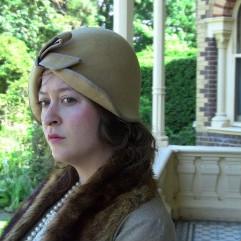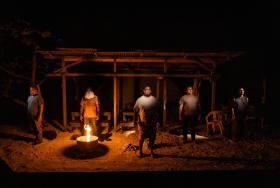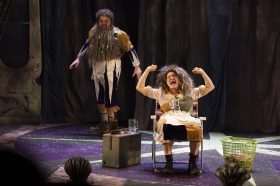I’ve seen the opening nights of one-person shows where nervous actors betray themselves, effectively killing the atmosphere only they can control. The audience members become unintentional vultures, feeding off what they are given. Any performer who takes on such a role challenges their abilities to continuously engage and entertain an audience for an extended period of time. While I admire those who try, it seems rare to find a play and an actor that can achieve this feat.
With that in mind, consider that once Murder at Warrabah House ended on its opening night, people seemed determined to keep applauding even when performer Samantha Hill had left the stage. I’ve seen what happens when a one-man show goes wrong; this is a welcome example of what happens when the performer and crew get it right.
With a nod to Agatha Christie, Murder at Warrabah House effectively muddles the familiar storyline. Set in 1928, the show opens with the classic murder mystery setting – an isolated house, a group of people of varying social status, a range of grudges and a sharp-witted detective – then turns the entire idea on its head.
The play begins with famous English detective Arthur Parrish and his dutiful sister Hattie being invited to stay at a manor in Kyneton, home of the wealthy McCutcheon family. When a mysterious death sparks Arthur’s detective instincts, a series of increasingly dark events force Hattie to confront some deeply conflicting emotions about the nature of familial bonds.
Samantha Hill exuded the air of an accomplished performer; from the moment she took the stage on opening night she was composed, in control, and maintained her (seven or so) alternating characters throughout the piece. Considering she had to pull off a range of English and Australian accents, both of the aristocratic and working class variety, she dodged a veritable minefield with believable and consistent execution. There’s nothing more unbearable for an audience when a British accent sounds more like it should be spoken in a high-school rendition of Oliver! rather than in an established theatre.
Recognition must also go to writers May Jasper and Sam Wilson, who have wisely resisted stuffing the script with hammy comedy and instead opted for a strong emotive core in Hattie as the narrator. While the storyline darts away from the standard Agatha Christie style, it was also happy to stay within the bounds of a plot-driven narrative, opting out of the opportunity to explore deeper emotional questions about Arthur and Hattie’s relationship. It seems like somewhat of a missed opportunity, as this could certainly have added greater depth to the eventual outcome of the play. And while the surrounding characters were appropriately comical, deftly drawn and well-executed, none of them had a background from which the audience could plumb insight. However, this less-is-more approach does work in favour of audience attention spans; the concisely written script keeps the show down to about an hour, effectively maintaining a strong narrative pace.
Having seen just how difficult it is for a one-person show to succeed, I am all the more appreciative of the work staged at SNAFU Theatre. Samantha Hill carried the show like a consummate professional, rewarding the work of the crew behind her performance. In this kind of situation, it would be all too easy for the performer to offer up overly hammy acting. While this may have been the case for the older, more eccentric and humorous characters to some extent, it wasn’t necessarily detrimental to the work at large. Arthur and Hattie were by far the most intricate characters, and with the most complex relationship. Hill wisely allowed them to retain the dignity and eloquence they needed for their interactions to become the bloodline of the story, threading life through everything else.
Murder at Warrabah House heads to the Edinburgh Fringe Festival in August; take a look before the Scots get into it.
SNAFU Theatre presents Murder at Warrabah House
Sudio 246: Rear of 246a Sydney Road, Brunswick (entry via Merri St)
February 24 – 26 and March 3 – 5
Bookings: email snafutheatre@gmail.com or call 0421 754 817





